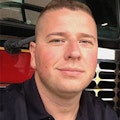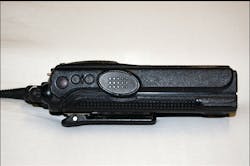Designing Portable Radios for Fireground Survival
In hazardous situations it is essential to maintain constant communications with all members operating on the scene. It is a well established fact that firefighters need to be equipped with radios to help ensure their safety and survival. Merely providing radios to members is not enough; they must be proficient at radio operations in order to quickly and efficiently declare a Mayday emergency in zero visibility, high stress environments. The radio must be designed to help ease an extremely stressful situation, and proper procedures must be followed to help ensure the critical messages will be effective.
Fire service radios need to be easily operated by members wearing full structural firefighting gear (PPE) who may be working in zero visibility conditions. There are several functional design features that should be incorporated in the radio specifications, including: a large push to talk button, large control knobs for ease of use and a channel layout that ensures transmissions will be heard by someone. It is imperative that members be able to utilize all the radio's features without removing their gloves and subjecting themselves to high heat and other fireground elements.
Push To Talk Buttons
Radios should have a large enough push to talk button (PTT) that can easily be operated with bulky firefighting gloves (see Photo 1). Radio transmissions often are not heard because the user thought the PTT button was depressed, but in actuality it was not. Many radios can be programmed to have a tone sound once the PTT is pressed to alert the user that they are transmitting. It is vital that, when a member needs to transmit a Mayday, it is heard by the incident commander.
Control Knobs
Radios should also have control knobs that are easy to operate with gloves on (see Photo 2). Many radios have small knobs that cannot be manipulated with structural firefighting gloves on. Members need to be able to transmit on the appropriate channel to be heard. If for some reason they inadvertently change channels, they must be able to return to the assigned channel or another monitored channel. Some radios have a continuous channel selector knob, which makes in nearly impossible to tell what channel the radio is on. LCD screens on the top or front of the radio often prove useless in a zero visibility environment. Radios should have channel selector knobs that have a clear start and stop point to be able to easily, and blindly, turn to a channel that is being monitored (see Photo 3).
Radio Programming
In addition to the hardware specifications, radio programming is also a crucial factor to allow a transmission of a Mayday. If a member accidentally switches channels during the operation, it is often difficult for them to navigate back to the appropriate fireground channel. A solution is to program the dispatch channel on the first and last channels of the radio. This allows the channel selector knob to be turned either direction and stop on the dispatch channel that is being monitored.
Another solution is to place the dispatch channel on one stopping point and a channel that does not go through a repeater (simplex channel) on the other stopping point. Oftentimes building construction can interfere with the radio being able to reach the repeater, which can cause a Mayday to be missed. Having a monitored simplex channel allows a member that is in trouble to reach someone if the repeated channel is not allowing their transmission to be heard.
Many radios now feature numerous banks to allow for communications with mutual aid companies. With this feature comes the problem of having the radio unintentionally changed to a different bank, and important transmissions can potentially be missed. A simple solution is to program the same first and last channel in every bank, so that no matter what bank the radio is on a member can still transmit a Mayday and be heard (see Photo 4).
Training
In order to reinforce the importance of radio design for firefighter survival, training on calling a mayday is essential. The importance of having a radio designed to easily rotate the channel selector knob either direction to a monitored channel should be emphasized. Members should be reminded that, if they do not receive an acknowledgement after several attempts on the selected radio channel, they should rotate the knob all the way in either direction.
For a training exercise, members should be given a radio on a fireground or training channel. While conducting the training members should wear full PPE, including a blacked out SCBA mask. Members should be brought into a room and given a situation that would warrant calling a mayday (for example: lost, trapped, etc) and they should attempt calling a Mayday on the fireground or training channel. After several attempts without acknowledgement from the incident commander, members should rotate the channel selector knob all the way in either direction to a monitored channel. This should be done without removing any PPE and in zero visibility conditions. Once again, the Mayday should be called and this time be answered by someone monitoring the channel. Remember to alert dispatch prior to the exercise that companies will be conducting mayday training.
Conclusion
Equipping members with radios is essential to firefighter survival, but without the necessary specification and training they are not as effective as they need to be. A Mayday is an extremely stressful situation, and having to fumble with a poorly designed radio will greatly amplify the stress level. Consideration must be given to the layout of the assigned radios to ensure that critical messages are effectively received. As always, training should be done by utilizing the equipment that has been assigned and by following the procedures that define the action steps and radio transmission requirements to maximize firefighter safety and survival.
JONATHAN HALL is a firefighter with the Saint Paul, MN, Fire Department. He previously served as a training and safety officer for the Township Fire Department in Eau Claire, WI and is a certified fire instructor for the Chippewa Valley Technical College in Eau Claire. Jonathan frequently teaches firefighter survival and rapid intervention team concepts in both Minnesota and Wisconsin.
About the Author

Jonathan Hall
Jonathan Hall, who is a Firehouse contributing editor, has more than 24 years of fire service experience. He currently is a captain with the St. Paul, MN, Fire Department assigned to Engine Company 14. Hall also serves as a lead instructor in the department's Training Division; he teaches hands-on skills to members of all ranks. Hall is the co-owner of Make The Move Training LLC and teaches engine company operations throughout the country.
